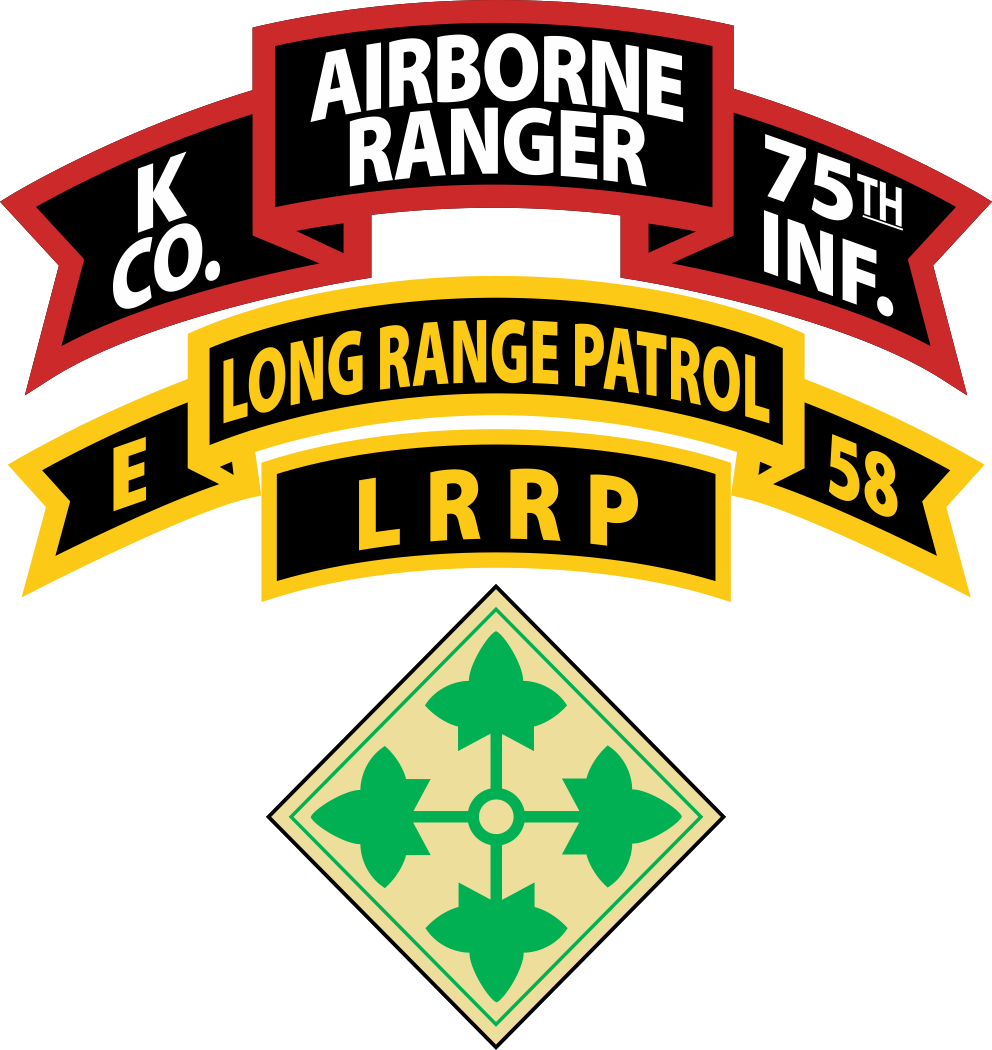HISTORY
OUR HERITAGE
This history deals with the activities, personnel, and accomplishments of Company K (Ranger), 75th Infantry (Airborne), during the period 1 February 1969 through 10 December 1970, and briefly highlights the history of the units that preceded, and led to the establishment of Company K (Ranger), 75th Infantry (Airborne).
Throughout history the need for small, highly trained, far ranging units to perform reconnaissance, surveillance, target acquisition, and special type combat missions has been readily apparent, in Vietnam this need was met by instituting a long range patrol program to provide each major combat unit with this special capability.
In an effort to link unit mission and unit heritage for such elite forces, the Department of the Army chose to redesignate existing long range patrol units as Ranger units and resurrect the heritage of the World War II long range penetration units, “Merrill’s Marauders,” in 1969. On February 1st, 1969, Company E (Long Range Patrol), 58th Infantry, was redesignated Company K (Ranger), 75th Infantry (Airborne), as part of this effort. The 75th Regiment was designated the official successor unit to the famous 5307th Composite Unit (Provisional) (Merrill’s Marauders).
Upon deactivation of Company E (Long Range Patrol), 58th Infantry, and activation of Company K (Ranger), 75th Infantry (Airborne), 1 February 1969, the successor company continued E/58th’s long range patrol operations under operational control of the 4th Infantry Division. This unit change was the end result of a prolonged process following the establishment of the first long-range patrol mission elements to support 4th Division operations in September, 1966.
Recondo (reconnaissance commando) patrol teams were established at battalion and brigade level during September, 1966, by Major General Arthur S. Collins, Jr., 4th Division commander. Although limited in scope and numbers, the early recondo teams proved their worth. In January 1967, the new 4th Division commander, Major General William R. Peers, began expansion and formalization of the program. At division level, the recondo teams were organized as the 4th Infantry Division, LRRP (Provisional), which saw service from September 1966 until December 20, 1967. Elements were also formalized at each of the three maneuver brigade headquarters; 1st Brigade LRRP, etc. Each brigade was authorized a sixty-two member reconnaissance platoon. The platoon was organized into a headquarters section (CO, XO, operations sergeant, and six radio operators), eight recondo teams, and three hawkeye teams. The brigade elements became fully operational during the first week of April, 1967, and participated in 4th Division operation FRANCIS MARION. The teams infiltrated enemy controlled areas to observe and conduct harassing activities.
The division-level recondo (LRRP) element was actually formalized after the brigades, although they had actually existed operationally since September of 1966. During June of 1967, MG Peers formalized the provisional 4th Infantry Division Recondo Detachment to supplement the brigade recondo resources. The division-level detachment contained eight recondo teams and three hawkeye teams, but no command section. The detachment was commanded and staffed as part of the intelligence section, 1st Squadron, 10th Cavalry. This structure gave the Recondo Detachment helicopter support and backup from the 10th Cavalry’s Troop D, Aero-Rifle Platoon.
Initially, the recondo (later LRRP) teams located landing zones and screened possible ambush sites ahead of regular units. During Operation SAM HOUSTON, Division reconnaissance was strengthened, and a division sniper course was instituted. Special recondo countermeasures patrols were formed to eliminate enemy couriers, officers, or sentries in surveillance areas. “Hawkeye” teams were raised by MG Peers, which included two division recondo members and two Rhade tribesmen who exhibited hunting and terrain prowess. Each team completed a ten-day course to learn mutual signaling and survival skills. At the time of formation, there was an initial doctrinal separation in recondo and hawkeye employment. However, that doctrinal difference became quickly blurred in actuality. Initially recondo teams were trained and tasked for three primary missions: (1) Trail Watching, to observe and report enemy movements; (2) Terrain Analysis, which included the important central highlands task of locating suitable landing zones; and, 93) Screening during division operations, to the front or flanks of regular infantry formations. Hawkeye teams, on the other hand, were used to engage enemy forces rather than strict gathering of intelligence. However, reality found that both type’s of teams became skilled at hit-and-run ambushes and gathering battlefield intelligence. While the actual size of each patrol varied, they ranged in size from three men to eight men depending on their assigned mission. As capabilities increased, so to did the length and complexity of the recondo-LRRP missions.
By June of 1967, 4th Division LRRP assets were conducting extensive operations throughout Pleiku Province, as well as in large swaths of Kontum and Darlac provinces on either side. Teams operated close to main enemy supply lines and staging areas, conducting a wide variety of long-range remote-area missions. The extended nature of the 4th Infantry Division operations required the recondo-LRRP teams to operate routinely at far greater distances from supporting units than other LRRP units in Vietnam. The teams frequently engaged in operations located far from established base camps having adequate communications facilities. Teams were often sent into operational radio-relay aircraft and ground teams. Brigade-level teams encountered similar operational ranges, but encountered more trouble securing radio-relay aircraft.
During operation FRANCIS MARION, April 6 to October 11, 1967, 4th Division recondo-LRRP elements proved their worth. During this period, with an average of forty-four operational teams, the recondo-LRRP elements completed 555 missions that produced 366 sightings of enemy personnel. Eighty-two of the missions resulted in direct contact with the enemy, resulting in ninety NVA/VC soldiers killed by direct team fire. Only Three Americans were killed. The 4th Infantry Division, LRRP (Provisional), earned a well deserved reputation as one of the finest recon units in Vietnam.
As part of the Department of the Army’s and MACV’s move toward a more formalized LRRP structure, the provisional division force was activated as Company E, 58th Infantry (Long Range Patrol), December 20, 1967. One of Major General Peers’ last acts before departing the division was elevating his provisional recondo-hawkeye forces to the status of an official long-range patrol company.
E/58th, under the direction of the new division commander, MG Charles P. Stone (January 1968), attempted a program that integrated South Vietnamese Army personnel with each team. From April 23 to June 21, 1968, thirty ARVN personnel were trained and integrated into E/58th teams. ARVN indifference, conflicts between the ARVN’s themselves, and other problems eventually doomed the program. The experiment was finally stopped in November, 1968. It failed to meet with the same success that was experienced with integrating Rhade tribesmen into the early recondo-hawkeye teams. Although carrying out numerous successful and harrowing long-range patrol missions during 1968, the unit also experienced alarming deficiencies in some operations. As with all units in Vietnam, E/58th suffered from the one-year combat rotation policy. They also experienced a shortage of MACV Recondo School and Ranger School graduates. In some instances, private’s first class was leading LRP teams.
On November 30, 1968, MG Donn R. Pepke, assumed command of the 4th Division. Renewed emphasis was placed on the importance of E/58th operations. Seasoned noncommissioned officers and Montagnard Rhade scouts were recruited. The value of loyal native expertise, previously demonstrated under MG Peers’ command, was being relearned. Members of E/58th continued to perform valuable LRP support for the 4th Division, until it was replaced by Company K (Ranger), 75th Infantry (Airborne), February 1, 1969.
The Department of the Army reorganized, redesignated, and activated the 75th Infantry to give each long-range patrol unit a common tradition and history under the combat arms regimental system. The history of the 75th began with the 5307th Composite Unit (Provisional) (Merrill’s Marauders) of World War II fame. Following their Burma campaign, the remnants of the 5307th were redesignated the 475th Infantry, which was reactivated February, 1969, as the 75th Infantry (Airborne). While there was to be no Regimental headquarters at the time, individual companies were activated and the regimental colors placed at Fort Benning, Georgia.
Company K (Ranger), 75th Infantry (Airborne), was initially activated under the command of Captain Reuben H. Siverling, using existing assets and personnel of E/58th. The newly activated ranger company’s mission was to proved long range reconnaissance, surveillance, harassment, and target acquisition patrol capability at division level in support of division operations. The 4th Infantry Division continued responsibility for an extremely large operational area, extending 200 miles along central Vietnam’s western border. From the northern An Lao alley of Kontum Province, across Pleiku and Darlac provinces, to Bu Krak in western Quang Duc Province. K/75th was assigned to 1st Squadron. 10th Cavalry, for administration and logistics, with operational control at division headquarters. K/75th did not operate at full efficiency until the brigade LRP platoons were integrated with the Ranger company. The three added platoons gave the company extra manpower and allowed it to reach its authorized 220 member strength level. K/75th completed its consolidation October 6, 1969, under the command of Captain Kim H. Olmstead.
K/75th was authorized a fifty-three man company headquarters and three patrol platoons. Each patrol platoon contained a headquarters section, five five-man ranger teams, and five six-man hawkeye ranger teams (the sixth person being a native scout). In actual service, there was little if any distinction between patrols, other than the presence or absence of a native (Rhade) scout, which varied considerably over the life of the unit. Each team was given an alphabet-numerical combination, such as R-12. Designation also related to the platoon, such as R-29 was a team within 2nd Platoon, and so on. The company headquarters included an extensive communications element that provided dedicated radio-relay teams. However, because of the difficult terrain in the area of operations, regular Ranger teams were pressed into service as relay teams when the need arose.
Constant personnel turnover plagued K/75 much as it had E/58. Although an influx of Ranger school graduates in late 1969 improved overall operations, actual school trained ranger and recondo remained scarce. However, non-ranger and recondo personnel continued the mission and turned in sterling performances. MG Glenn D. Walker, assumed command of the 4th Division in November 1969, and directed a series of ranger retaliatory missions. The new missions raised moral, aided recruiting and infused the company with new spirit. Camouflage fatigues became more readily available and the Ranger black beret replaced the Australian-style cowboy hat as the unit’s headgear. K/75 participated in a wide variety of missions, both combat and reconnaissance. Under MG Walker, the emphasis on combat missions increased. More often that not, teams were deployed to conduct ambushes.
Ranger Designation:
The rational for selecting the 75th Infantry as the parent unit for all Department of the Army authorized Ranger unit’s is/was as follows:
Similarity of missions between those missions performed by Merrill’s Marauders (5307th) and the 75th Infantry Ranger companies in the Republic of Vietnam, and those of the 75th Ranger Regiment operations deep in enemy controlled territory.
It returns to the rolls of active Army regiments a unit having a distinguished combat record and a unique place in the annals of the United States Army.
It provides the 75th Ranger Regiment and the United States Army with a common regimental designation identifying an uncommon skill.
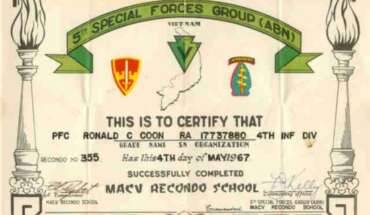
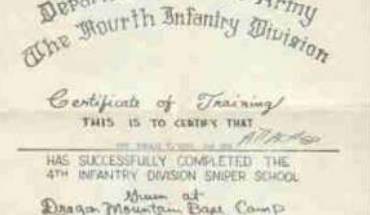
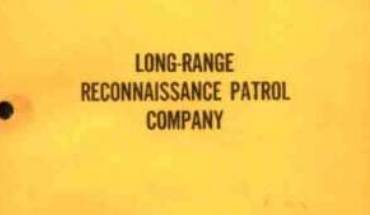
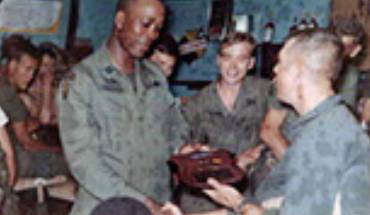
During mid-February 1970, the K/75 Rangers participated in a prisoner rescue mission known as Operation WAYNE STAB II. The operation saw the entire company consolidated and deployed as a unit in a raid on a rear area enemy POW compound.
The remainder of the time found the K/75 Rangers conducting interdiction patrols along enemy infiltration routes, area and point reconnaissance missions, ambush patrols, sniper missions, and other ranger-type long range patrols. Although normally operating in for to six man teams, teams were occasionally combined into eight to twelve man heavy teams for special operations. The unit performed Herculean service over an extremely large area of operations. An area that often lacked the artillery, aerial, and communications support available to other ranger units. The K/75 Rangers combated an influx of well-trained and confident North Vietnamese regiments in the tri-border region, as well as dedicated Viet Cong forces. Despite these dangers and difficulties, Company K and its predecessor LRP units rendered significant military service to the II Corps Tactical Zone and the 4th Infantry Division, K/75 Rangers served as a vital force multiplier in a wide-ranging area of operations. The Rangers located and identified key enemy forces, interdicted enemy supply networks, base camps, way stations, and storage points; and actively screened and guarded the flanks of regular Infantry operations. Its large area of operations caused K/75 Rangers to consistently cover more territory and shoulder greater reconnaissance responsibilities, over a wider area, than most other division ranger companies in Vietnam.
K/75 Rangers continued field operations in Vietnam until November 22, 1970. As part of Increment V (Keystone Robin-Bravo) of the US Army redeployment from Vietnam, K/75 Rangers was ordered to stand-down. On the morning of November 26, 1970, MG William A. Burke (assumed command of 4th ID in July 1970), mustered the Rangers for a final review and decorations ceremony. As the final, and second, commander of K/75 Rangers, Captain Larry E. Penley, presided as the company was officially reduced to zero strength and inactivated December 10, 1970. Although some of the K/75 Rangers were immediately returned home, others were reassigned to ranger units to “continue the mission.”
Company K (Ranger), 75th Infantry (Airborne), is entitled to the following:
Campaign Streamers:
Vietnam:
Counteroffensive Phase VI
Tet 69 Counteroffensive
Summer-Fall 1969
Winter-Spring 1970
Sanctuary Counteroffensive
Counteroffensive Phase VII
Decorations:
Vietnam:
RVN Gallantry Cross w/Palm
RVN Civil Actions Honor Medal
Traditional Designation: “K” Rangers
Motto: “Sua Sponte” (“of their own accord”)
Distinctive Insignia: The shield of the coat of arms
Symbolism of the Coat of Arms: The colors Blue, White, red, and green, represent four of the original six combat teams of the 5037th Composite Unit (Provisional), which were identified by a color code word. The unit’s close cooperation with the Chinese forces in the China-Burma-India Theater is represented by the sun symbol from the Chinese Nationalist flag. The white star represents the Star of Burma. The lightening bolt is symbolic of the strike characteristics of the behind-the-line activities of the unit.
